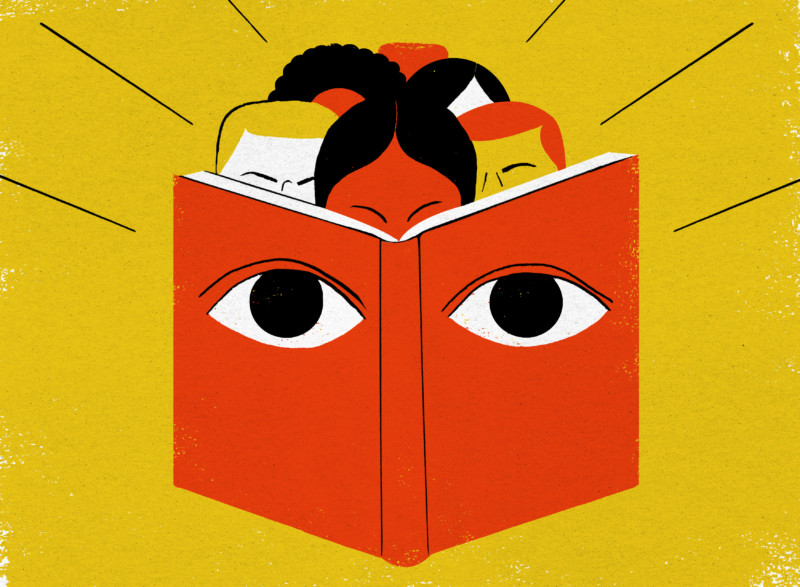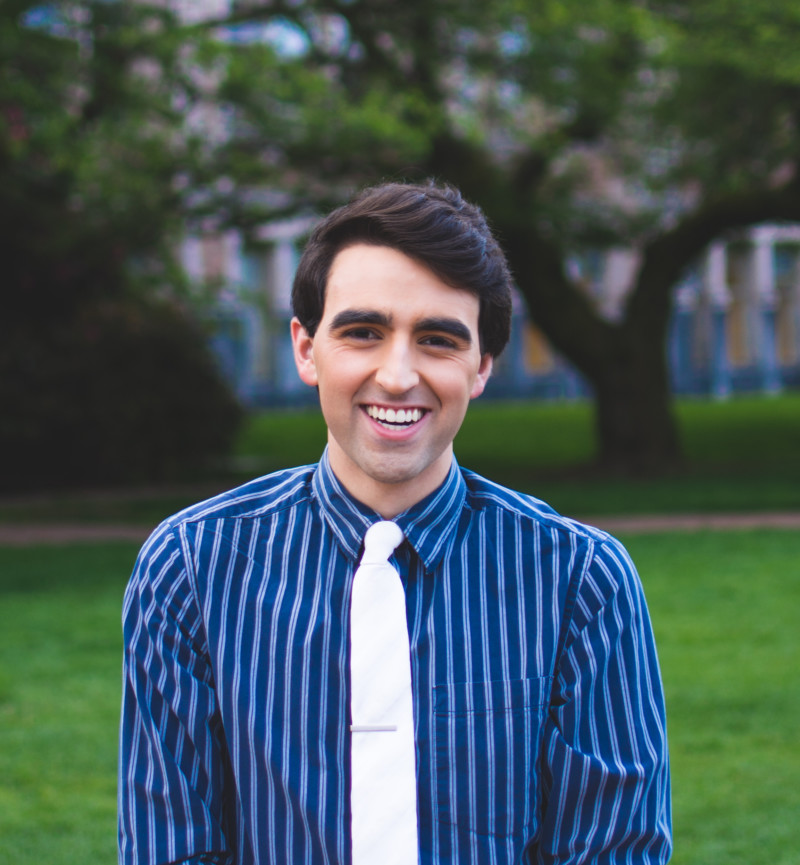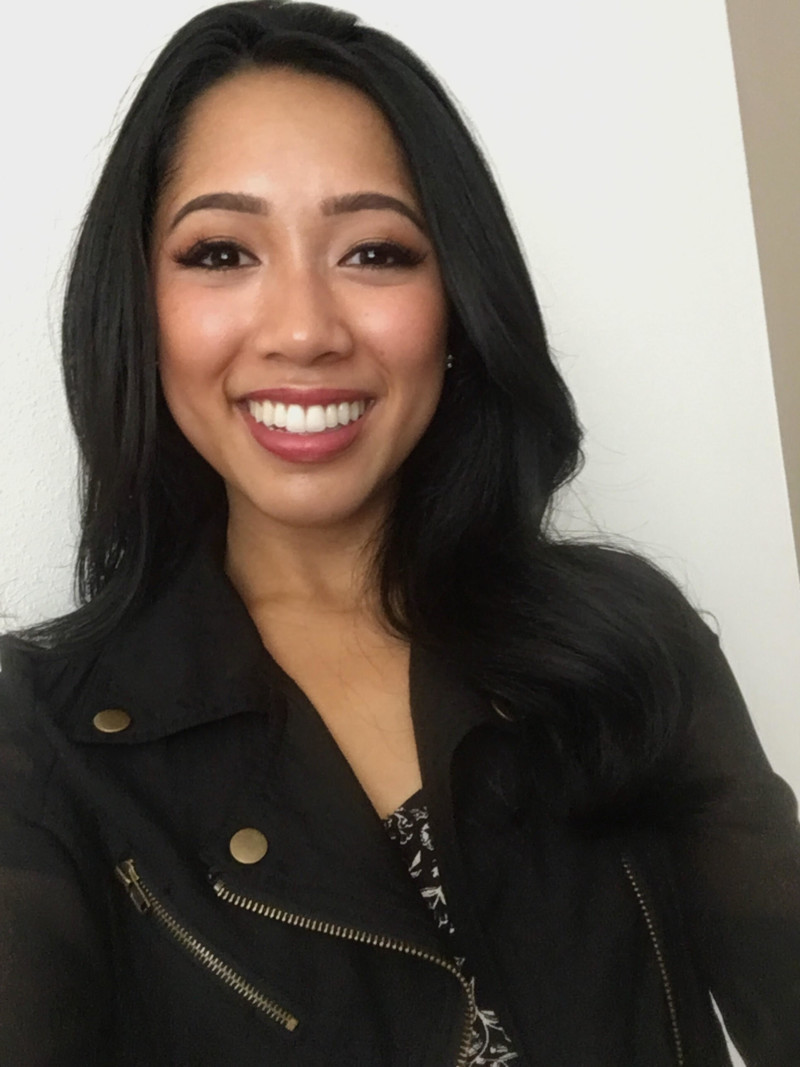How Trump Is Making Journalism School Great Again
Professor Carl T. Bergstrom began his first lecture for INFO198 at the University of Washington with a announcement about America. "There is then much bullshit," he said, looking up at 160 students final bound. "We are drowning in information technology." Bergstrom's audition didn't seem surprised or outraged by his phraseology. They had surely heard that word before, merely they no doubt as well recognized it from the championship in the course catalog: "Calling Bullshit in the Age of Big Information."
As Bergstrom spoke, a flick of Hillary Clinton and Donald Trump appeared on a screen behind him, followed moments later past a photo of a young adult female typing on her telephone. "The average American spends nearly an hour a twenty-four hour period on Facebook," he said. "Doing what? Generally spreading bullshit." The students laughed. Then Bergstrom shouted, "Plenty! Plenty bullshit! We are tired of this."
That roughly explains how Bergstrom, an evolutionary biologist, wound up in a lecture hall declaring war on faux news. He and his colleague Jevin West, a data science professor, launched the class this past spring, not long after hoax stories, Russian bots, and clickbait headlines wreaked havoc on the U.s. electoral process. The professors were besides concerned well-nigh misleading science stories, journalism by press release, and the mode interest groups and corporations twist data. The course filled up in less than a minute, with several hundred students turned away.
"We wanted to teach students how to evaluate the onslaught of information in their lives," Due west tells CJR. "At that place'south data warfare going on right at present."
Every bit a information expert, West lives in a world where algorithms and automobile learning solve man bug. He is encouraged that Facebook, Google, and Twitter are rolling out such tools to eradicate fake news and surface trustworthy content. But he knows that ones and zeros alone tin't solve the problem.
Subsequently in the semester, West and Bergstrom offered students a hitting reason why, examining a fake news story about vaccines causing shaken baby syndrome. The claim was then absurd that literally no content existed online to refute it. Searching Google for this phrase—"practice vaccinations cause shaken baby syndrome?"—only turned upwards links to other bogus websites that repeated and expanded on the invented data.
"We need a cultural solution as well," West tells CJR. "That's why nosotros're doing this."
At to the lowest degree a dozen universities effectually the country have launched or are planning similar classes, using "Calling Bullshit" and curriculum from Stony Brook University'due south Eye for News Literacy as templates. There has been a flare-up of interest in secondary teaching likewise, with legislators in at least xv states introducing or recently passing laws mandating digitally focused media literacy teaching in public schools.
"This can get real," West said that first day of class, taking over the mic from Bergstrom. "And when the shit gets real, that's when we should care equally a gild."
Faux news is not new.
Humans have manipulated and made information for centuries—to persuade, confuse, entertain. There was Yellow Journalism, of course. During World State of war II, the United States used propaganda on American citizens to rally the state. And Adolf Hitler was a chief of faux news.
Also not a new idea: media literacy. In the 1930s, an ex-journalist named Clyde Miller started the Establish for Propaganda Analysis, which designed curriculum for educators to teach students to recognize vii different propaganda devices. One was "glittering generalities," defined as "[a]n attempt to sway emotions through the apply of shining ideals or virtues, such as liberty, justice, truth, didactics, republic in a large, general way."
Schools take taught media literacy concepts for decades, but plain never in an surroundings like this one, where owning a printing press or TV satellite isn't needed to quickly and widely disseminate information. That, combined with hyperpartisan politics, has led to the weaponization of news by individuals, political groups, and foreign countries.
The one-time tools of media literacy—source checking, relying on known outlets—aren't enough when a hacker in Macedonia can easily create a website that looks legitimate, and so apace make thousands of dollars from advertising equally bogus stories circulate. Scrolling through social media feeds produces one challenge later on another, from the serious to the mundane.

Illustration by Hanna Barczyk
Just enquire the "Calling Bullshit" students.
"Then many people just see stuff and share it," says Conner Ardman, nineteen, who took the form and plans to major in Informatics with a concentration in data science. "They don't even look at it. They accept no idea what it is."
Early in the semester, the professors displayed several memes that had been circulating online. The students voted electronically on whether the claims were true.
"You need to be conscientious on the toilet, you guys," West said, showing a widely shared picture of a toilet with text reading, "No i tells yous, but more 30,000 Americans are injured each year in the process of using the toilet."
Much laughter.
"Bullshit" West said. "Or non bullshit?"
The students voted. Roughly 65 percent thought information technology was bullshit.
"It'southward not bullshit," W said. "This 1 is really true. People actually do go injured on toilets."
The truth of toilet danger raises a rather profound question for our time: If something online that sounds ridiculous is true, how can internet users know if something that sounds potentially plausible is really faux? That'due south what classes similar "Calling Bullshit" are trying to address. Though fake news might seem similar a know-it-when-you-see-information technology nuisance, students say that social networks make it exactly the opposite.
"Information technology'south hard because you unremarkably trust your friends when they tell you lot something," says Jessica Basa, xx, a University of Washington computer scientific discipline and computer science major who took the class. "They're non trying to flim-flam y'all when they postal service stuff they think is interesting simply isn't truthful."
Some of the didactics seems old and obvious, yet also newly relevant. Equally a showtime line of defense, the "Calling Bullshit" professors instructed students to ask themselves three questions when encountering a news story, scientific study, or complicated data: Who is telling me this? How do they know it? What'due south in it for them?
"If yous were going to a car dealership, you would be request these types of questions," Westward said during a lecture. "We want you to have that kind of frame of heed going forward . . . .Y'all should put your skeptical hat on, especially when you're in these digital environments."
W and Bergstrom introduced theoretical defenses as well, such as Occam's Razor, a 14th century principle that says the simplest caption is usually correct. They paired this with the then-called "Bullshit Asymmetry Principle," an thought tweeted by an Italian software developer in 2013. It states, "The amount of energy needed to refute bullshit is an order of magnitude bigger than to produce it." For evidence, the professors offered the Comet Ping Pong saga—allegations that Hillary Clinton ran a kid sex ring in the basement of a Washington, DC, pizza store. The fiction took months to dislodge, and references nonetheless popular upward on social networks, shared by those who believe it or simply want to use it as ammo against the opposition.
Other detection tactics, such as the ones taught at Stony Beck, are more technical and workmanlike, but every bit important. Students are taught how to look up domain name registration records. Though these records can exist fudged, any English-language news site originating in Eastern Europe—the vast majority of fake news is manufactured there—is likely to exist bogus. Another tool: paradigm searches. To track downward a photo's origins, simply drop the questionable epitome into the search bar on Google Images. Definite alert signs: poor grammar and cheap-looking design.
Stony Brook became a leader in media literacy soon afterwards Howard Schneider, a former Newsday editor, founded the university'south journalism school in 2006. Besides training the adjacent generation of journalists, Schneider was prophetic in recognizing that there should be, every bit he put it in a 2007 Nieman Reports commodity, an boosted mission "of equal—perhaps greater—importance: to educate the next generation of news consumers."
"The digital revolution might bring the promise of enlightenment, but in its pathological lack of accountability might only as hands spread a virus of confusion and disinformation," Schneider wrote. "The ultimate bank check against an inaccurate or irresponsible press never would be just improve-trained journalists, or more press critics and ethical codes."
What was the answer?
"Consumers who could differentiate between raw, unmediated information coursing through the Internet and independent, verified journalism," Schneider wrote.
More than than 10,000 students have taken Stony Brook'southward news literacy course, which is constantly updated to help students identify the latest ways artificial news and information are created. For instance, there are dozens of websites that permit anyone easily produce counterfeit social media posts, then retweet them, mail them on Facebook, or embed them in a news story. But faux tweets seem positively quaint compared to an fifty-fifty newer threat: Using artificial intelligence to make videos of people saying things they didn't say. Researchers recently made a video of Barack Obama speaking very earnestly nearly his priorities for the waning days of his administration.
"The unmarried most important affair I tin can do now," Obama said, according to the doctored sound track, "is to play golf."
The following judgement is not false news, nor does it rely on bullshit data: Media literacy works, and it just might save humanity. At least role of that sentence is backed up by a recent study that examines how people guess the accurateness of claims about controversial subjects. Researchers from the University of California, Riverside, and Santa Clara Academy provided more 2,000 teenagers and adults upwards to age 27 with false assertions continued to stories on highly charged topics such every bit economic inequality and tax policy. The study plant that claims about controversial topics, whether true or false, were more than often than not identified as accurate if they aligned with the person'southward prior views. That's essentially confirmation bias, seeking out and believing information that strengthens your worldview. Sobering. Also, not surprising.
And then the researchers dug further into the information, producing remarkable findings. They looked at ii subsets of study subjects: those with higher than average political knowledge but no media literacy training, and those who had little or no political knowledge but took media literacy courses. Having political knowledge "did not ameliorate judgments of accuracy," the authors wrote. Media literacy didactics did. Other contempo studies have hinted at like success, but it's unknown whether these lessons behave as much weight once students enter the real world.
The Academy of California authors were cautiously optimistic, noting the results seem to advance the notion of so-called "critical loyalty." "Those with disquisitional loyalty all the same hold strong values and beliefs," the authors write, "but they adopt a disquisitional stance when evaluating an argument—even when that argument aligns with their partisan preferences." In other words, those with media literacy training can nevertheless be fiercely committed to their world view, but they tin can as well successfully question flimsy claims. They can call bullshit. Perhaps they tin fifty-fifty stop spreading it.
Some circumspection about these results is warranted. People don't just share fake news because they don't know any better. A Pew Enquiry Middle survey concluding year found that 14 percent of The states adults shared news they knew was imitation. In many cases, researchers say, it's an identity thing—to show what groups and ideas they agree with, to feel part of a movement, fifty-fifty for entertainment. Then there'south the problem of book. Researchers take recently used complicated mathematical models to show that the sheer amount of information shared online—both real and imitation—creates a sort of whack-a-mole situation, in which many moles survive to surface another 24-hour interval.
Nonetheless, media literacy educators are excited by this moment. For one thing, they hope it leads to more resources. This past summer, the Knight Foundation awarded $1 million in grants to 20 media literacy projects around the land, including "Calling Bullshit." But educators as well hope the enthusiasm will lead to meaningful changes in how students and adults deal with the onslaught of digital information. They are especially encouraged that both ruddy and blue states are passing or considering laws mandating new digitally focused media literacy initiatives at the secondary school level. California, a liberal bastion, passed one such mensurate. Texas, at the other end of the political spectrum, is contemplating one.
At the last lecture of "Calling Bullshit," Bergstrom focused on a future in which the class's inaugural students become out into the world with their new skills, share what they know, and stop bullshit in its tracks.
"Starting with this class and spreading out further," he said, "I'm hoping we can make a deviation."
Ardman, the computer science major, is already trying. Non long ago, a friend on Facebook posted a story saying an FBI agent investigating Hillary Clinton's private email server had killed his wife, then himself.
"This can't be right," Ardman thought.
He checked information technology out and posted a comment with his findings: fake news.
"It'southward important to call it out," Ardman says. "It's your borough duty."
Dorsum to school
For today's college students, a dubious story, photo, or video shared by a friend on social media can enter the bloodstream faster than a Jello shot. Here are some central takeaways from students enrolled in some of the growing number of media literacy classes at colleges and universities around the country.

Sara Schabe
Inferior, Stony Brook Academy
Major: Journalism
"I was similar, 'I'm such an idiot.' "
Earlier Hurricane Sandy hit New Jersey a few years ago, Schabe saw a photo online of an eerie storm cloud looming over New York Urban center. "I thought it was a real movie," she says. In course, she learned it was doctored from a movie. "I was like, 'I'thousand such an idiot.'"
Lesson learned: apply Google's reverse image search to check whether photos are legit.

Navid Azodi
Senior, University of Washington
Major: Business and data systems
"Just liking one fake story can go this huge downward spiral."
"Some of these fake news sites look totally existent," Azodi says, pointing to the widely shared simulated news story about the Pope's endorsement of Donald Trump. "Just liking ane simulated story can become this huge downward spiral."
Lesson learned: If a news outlet is unfamiliar, await up domain records and use online fact-checkers such equally Snopes.

Starla Sampaco
Senior, University of Washington
Major: Video journalism
"Debunking simulated news is really hard."
A surprising merely key research finding about fake news is that the more a claim is refuted, the harder information technology is to deflate, especially among those with strong ideological views. "You can't simply proceed saying something isn't true," Sampaco says. "That's why debunking simulated news is really hard."
Lesson learned: People don't just share faux news considering they've been duped—it's a manner to strengthen their ain behavior and position.

Gary Ghayrat
Inferior, Stony Brook University
Major: Journalism
"You have to use multiple sources. "
"It was really shocking to learn what a rigorous process it is to publish a story," Ghayrat says. "You have to accept multiple sources [and] corroborate them with other sources to make sure you're getting everything right."
Lesson learned: Look for the basics of journalism in every story. Are the sources named? Who provided the data? Is there an opposing viewpoint? Is it likewise good to be true?
Has America ever needed a media watchdog more than now? Help us by joining CJR today.
Michael Rosenwald is a reporter at the Washington Post. He has besides written for The New Yorker, Esquire, and The Economist. Follow him on Twitter @mikerosenwald.
TOP IMAGE: Analogy by Hanna Barczyk
Source: https://www.cjr.org/special_report/media-literacy-trump-fake-news.php
0 Response to "How Trump Is Making Journalism School Great Again"
Post a Comment